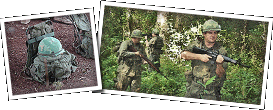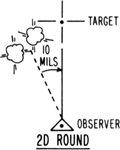Requesting and Adjusting Artillery Fire
From Guide For Squad Leaders, Pam 350-12, May 1967
- General
Despite the availability of artillery observers, infantrymen are often in the best position to observe and adjust artillery fire. Accordingly, every infantryman should be capable of requesting and adjusting artillery fire should the need arise. In general, procedures are the same as for conduct of fire with mortars. - Adjustment of Fire
The purpose of the call for fire is to place fire on or as close to the target as possible. If the initial rounds are not "on target", an adjustment must be conducted. The observer selects a point upon which to adjust. This should be a well defined point near the center of the area occupied by the target. The purpose of the adjustment is to move the center of impact to within 50 meters of the adjusting point. This is done by sending the FDC subsequent corrections for lateral deviation and range. The bursts are moved to and kept on the observer-target line in order to obtain positive range spottings. Range corrections are made to enclose the target between two successive rounds, thus establishing a bracket. This bracket is then split until the observer is assured that the next rounds will be within 50 meters of the target. He then calls for fire for effect. When the range spotting is doubtful, a deviation correction (to place the burst on the observer-target line) is requested. If the initial rounds or any succeeding rounds bracket the target for range (one round over and one round short), the request "fire for effect" is sent to the FDC. Fire for effect will consist of several batteries or the battalion firing one or more rounds. Distribution of weapons and normal dispersion will cause shell fragments to saturate the target area. - Preparation of the Call for Fire
The location of the target may be given in any manner clearly understandable to both the observer and the fire direction center. Regardless of the method used to designate the ground location of the target, the observer-target direction (in mils) must always be given. This can be obtained through the use of a compass, a map, or by comparison with a known direction. Normally, one of the following methods of designating the ground location is used:- Grid coordinates. Determine the grid coordinates of the target location. Example: Grid 734536, Direction 4800 (measure with compass).
- Shift. From a registration point, reference point, a numbered target, or any other point the location of which is known to both observer and the fire direction center. The shift is announced as so many meters right or left and so many meters over (add) or short (drop) of the reference point. Example: With your field glasses you determine that your target is 200 mils to the right and about 400 meters short of the registration Point 1. You have determined that the distance from observer to the registration point is 3000 meters and the direction to the registration point is 1600 mils. To compute the shift you multiply the 200 mils times 3 (distance in thousands) equals 600 meters. You then direct the shift as follows: From Registration Point 1, Direction 1800 (1600 mils plus 200 mils), right 600, drop 400.
- Polar coordinates.
- It observer location is known by the fire direction center, the target location may be reported by giving the distance from the observer to the target along with the OT direction. Example: Determine direction (azimuth), estimate or measure distance, then give the information—Direction 120, distance 2100.
- If target location cannot be obtained, a marking round may be used to determine shift to target. Example: Request the fire direction center to "Mark center of sector" or "Mark Registration Point I." Observer may request air burst or smoke rounds to assist in locating the initial rounds.
- The Call for Fire
The call for fire should include the following elements in the sequence indicated below:
Element Example a. Identification of Observer Red Leg 18 this is Big Boy 25; or FDC I am the platoon leader of 1st platoon, alfa company. b. Warning Fire mission. c. Location of target Grid 734536, Direction 4800; or From Reg Pt 1 Direction 1800, Right 600, Drop 400; or Direction 120, distance 2100. d. Description of target 15-man patrol. e. Method of fire and control Adjust fire; or fire for effect (if the location of the target is accurate within 50 meters and the fire for effect will be effective without any adjustment). - Spotting
A spotting is a brief description of where the rounds landed with relation to the target. It assists the observer in developing his subsequent correction. Spottings are made from the center of the adjusting rounds. The sequence of the spotting is range and deviation. Spotting terms and examples are shown below:- Range: Over, Short, Doubtful, or Range Correct.
- Deviation: Left, Right, or Line.
- Rounds that are not seen: Lost.
- Subsequent Corrections
Visualize an imaginary line (OT line) from observer to the target. All correction for deviation will be in relation to the OT line; corrections for range will be in relation to the target. After adjustment has started, the observer sends the fire direction center corrections to be applied to the next rounds. Corrections are given in the following order:- The lateral deviation (in meters) of the burst center with respect to the OT line. The angular deviation in mils is converted to meters by multiplying the number of mils deviation by the OT factor. This is simply the estimated distance to the target in thousands of meters (rounded to the nearest thousand meters). Example: OT factor for an estimated OT distance of 3400 meters = 3.
- The desired range change in hundreds of meters. Normally, range bounds are 100, 200, 400 meters, with the objective of immediately establishing a bracket on the target. After an initial bracket is obtained, it is successively split until a 100-meter bracket is split; at that time Fire for Effect is requested.
- To conclude a fire mission, the observer reports "End of Mission" and the results of the fire for effect.
Example
|
The first adjusting round landed 50 mils left of the target and was doubtful for range. SPOTTING: Doubtful. 50 left. CORRECTION: "Right 150." |
|
The second adjusting rounds landed short and 10 mils to the left. SPOTTING: Short, 10 left. CORRECTION: "Right 30, Add 400." NOTE: From the spotting of short, the observer decides to make a range change of 400 meters in order to bracket the target with the next round. |
|
The third adjusting rounds landed over and on line with the target. SPOTTING: Over, Line. CORRECTION: "Drop 200." NOTE: Splits 400 meters bracket. |
|
The fourth adjusting rounds landed short and 5 mils to the right. SPOTTING: Short, 5 Right. CORRECTION: "Add 100." NOTE: Lateral deviations of less than 20 meters may be ignored during the adjustment. However, prior to going into fire for effect, errors of 10 meters or more will be corrected. |
|
The fifth adjusting rounds landed over and 5 mils to the right. SPOTTING: Over, 5 Right. CORRECTION: "Left 20, Drop 50, Fire for Effect." NOTE: This correction will place fire within 50 meters of target, so observer requests fire for effect. Corrections in deviation are sent to the nearest 10 meters. |
|
Fire for effect landed all around the target, neutralizing
it. The observer sends "End of Mission," followed by a report
of the effect, "Estimate 10 Casualties." |








